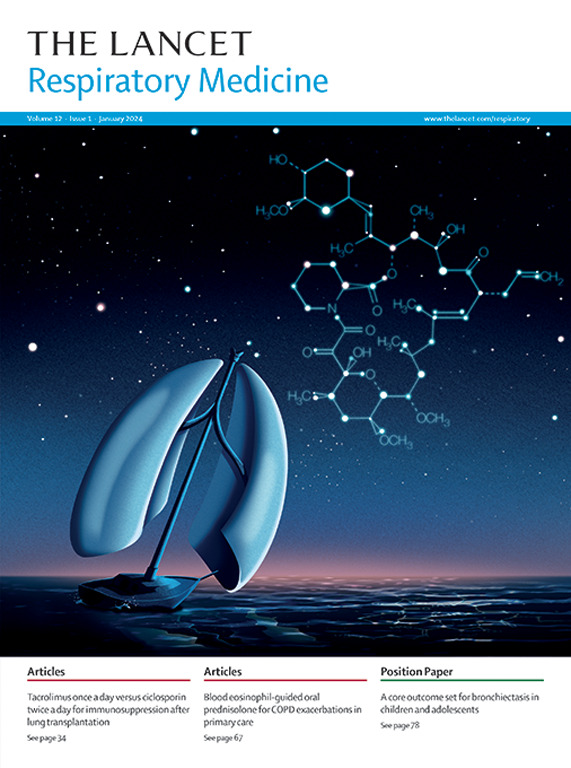Association of respiratory drive and effort with mortality and time to discharge in patients on mechanical ventilation in Canada: a longitudinal, prospective, registry-based cohort study
IF 32.8
1区 医学
Q1 CRITICAL CARE MEDICINE
引用次数: 0
Abstract
Background
Physiological data suggest that insufficient and excessive respiratory drive and effort during mechanical ventilation might injure the lung and diaphragm, but their clinical relevance is unknown.Methods
In this prospective, registry-based cohort study from the Toronto Intensive Care Observational Registry, we included all adults on mechanical ventilation admitted to the medical-surgical intensive care unit (ICU) at Toronto General Hospital from June 25, 2019, to April 1, 2022. There were no exclusion criteria. We obtained daily measurements of drive (airway occlusion pressure, P0·1), effort (expiratory occlusion pressure, Pocc), lung stress during spontaneous breathing (dynamic transpulmonary driving pressure, ΔPL,dyn), and ventilator-delivered dynamic driving pressure (ΔPaw,dyn) for the first 10 days of mechanical ventilation. Daily hazards of death in ICU or discharge alive from ICU were quantified using Cox proportional hazards models adjusted for changing severity of illness over time.Findings
We included 1186 patients. 298 (25%) patients died during follow-up. P0·1 and Pocc showed a non-linear association with the hazards of death and discharge alive (p≤0·024). In patients with a ratio of arterial partial pressure of oxygen to inspired fraction of oxygen (PaO2:FiO2) of 150 mm Hg or less, both low and high levels of P0·1 and Pocc were associated with lower rate of ICU discharge; when PaO2:FiO2 was greater than 150 mm Hg, higher P0·1 and Pocc were associated with accelerated ICU discharge (interaction p<0·0001). High ΔPL,dyn was associated with lower rate of ICU discharge (p<0·0001), especially when PaO2:FiO2 was less than 150 mm Hg. Higher effort magnified the association between ΔPaw,dyn and rate of discharge alive (interaction p=0·0052).Interpretation
In patients on mechanical ventilation, insufficient or excessive respiratory drive and effort were associated with higher ICU mortality and lower rate of ICU discharge, particularly when oxygenation was more severely impaired. Elevated respiratory effort exacerbated the effect of ventilator-delivered driving pressure on outcome.Funding
National Sanitarium Association, Canada.加拿大机械通气患者呼吸驱动和努力与死亡率和出院时间的关系:一项纵向、前瞻性、基于登记的队列研究
生理数据表明,机械通气时呼吸驱动和用力不足和过度可能会损伤肺和膈肌,但其临床意义尚不清楚。方法在这项来自多伦多重症监护观察登记处的前瞻性登记队列研究中,我们纳入了2019年6月25日至2022年4月1日在多伦多总医院内科-外科重症监护病房(ICU)接受机械通气的所有成年人。没有排除标准。我们获得了机械通气前10天的每日驱动(气道闭塞压,P0·1)、用力(呼气闭塞压,Pocc)、自主呼吸时肺应激(动态经肺驱动压,ΔPL,dyn)和呼吸机传递的动态驱动压(ΔPaw,dyn)的测量值。使用Cox比例风险模型,根据疾病严重程度随时间的变化进行调整,对ICU每日死亡或从ICU活着出院的风险进行量化。结果纳入1186例患者。随访期间死亡298例(25%)。P0·1和Pocc与死亡和活出院危险度呈非线性相关(p≤0.024)。动脉血氧分压与吸入氧分数之比(PaO2:FiO2)小于或等于150 mm Hg的患者,低、高水平的P0·1和Pocc与较低的ICU出院率相关;当PaO2:FiO2大于150mmhg时,较高的P0·1和Pocc与ICU加速出院相关(相互作用p<; 0.0001)。高ΔPL,dyn与较低的ICU出院率相关(p< 0.0001),特别是当PaO2:FiO2小于150 mm Hg时。更高的努力放大了ΔPaw,dyn与活出院率之间的关联(相互作用p= 0.0052)。在机械通气患者中,呼吸驱动和努力不足或过度与ICU死亡率升高和ICU出院率降低相关,特别是当氧合受损更严重时。呼吸力升高加重了呼吸机驱动压力对预后的影响。加拿大国家疗养院协会。
本文章由计算机程序翻译,如有差异,请以英文原文为准。
求助全文
约1分钟内获得全文
求助全文
来源期刊

Lancet Respiratory Medicine
RESPIRATORY SYSTEM-RESPIRATORY SYSTEM
CiteScore
87.10
自引率
0.70%
发文量
572
期刊介绍:
The Lancet Respiratory Medicine is a renowned journal specializing in respiratory medicine and critical care. Our publication features original research that aims to advocate for change or shed light on clinical practices in the field. Additionally, we provide informative reviews on various topics related to respiratory medicine and critical care, ensuring a comprehensive coverage of the subject.
The journal covers a wide range of topics including but not limited to asthma, acute respiratory distress syndrome (ARDS), chronic obstructive pulmonary disease (COPD), tobacco control, intensive care medicine, lung cancer, cystic fibrosis, pneumonia, sarcoidosis, sepsis, mesothelioma, sleep medicine, thoracic and reconstructive surgery, tuberculosis, palliative medicine, influenza, pulmonary hypertension, pulmonary vascular disease, and respiratory infections. By encompassing such a broad spectrum of subjects, we strive to address the diverse needs and interests of our readership.
 求助内容:
求助内容: 应助结果提醒方式:
应助结果提醒方式:


